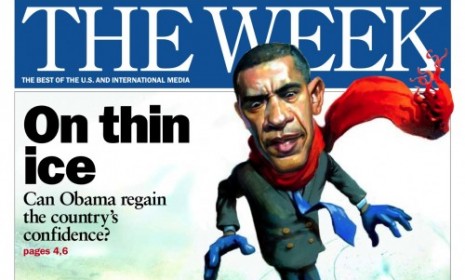Book of the week: Playboy and the Making of the Good Life in Modern America by Elizabeth Fraterrigo
Part of Playboy's appeal was in promoting an idea of the good life, and Fraterrigo is less interested in how Playboy changed Americans’ sex lives than in how it changed our mind-set as consumer

(Oxford, 320 pages, $29.95)
“Even in its heyday,” Playboy magazine promoted an idea of the good life that was “a yokel’s idea of sophistication,” said Edward Kosner in The Wall Street Journal. That doesn’t mean the idea wasn’t powerful. Seven million copies of Hugh Hefner’s 1950s brainchild were selling each month by 1972, a year when Hefner’s empire of disrobed women included 40 Playboy clubs and “the world’s most profitable gambling joint.” Whether topless “bunnies” and Hefner’s all-pajama wardrobe accelerated or merely reflected a shift in social and sexual mores is a “chicken-and-egg question” that might not seem worth worrying about. Leave it to an “earnest academic” to sift the evidence and reach a surprising conclusion: Playboy acted less as a battering ram to Eisenhower-era conformity than as a flagship for a new “orthodoxy of individuality.”
“Be forewarned,” said Noreen Malone in Slate.com’s Double X. Elizabeth Fraterrigo’s Playboy tome is written for academic audiences and is not “remotely titillating.” Fraterrigo is far less interested in how Playboy changed Americans’ sex lives than in how it changed our mind-set as consumers. Hefner’s genius was in recognizing “deep unrest in the men he saw around him,” said Julia Keller in the Chicago Tribune. A year before the 1953 launch of Playboy, Hefner was an unhappy office worker in an unhappy marriage. He understood other men’s “frustration with the bland regularity of the roles they were expected to fill.” Embracing independence and bachelorhood, he created a magazine that told men they might be happier if they had extra cash in their pockets and jazz on the hi-fi, and were chasing bedmates who didn’t want babies. Playboy showed men an escape plan and “presented it to advertisers, tied up in a ribbon.”
The Week
Escape your echo chamber. Get the facts behind the news, plus analysis from multiple perspectives.

Sign up for The Week's Free Newsletters
From our morning news briefing to a weekly Good News Newsletter, get the best of The Week delivered directly to your inbox.
From our morning news briefing to a weekly Good News Newsletter, get the best of The Week delivered directly to your inbox.
Playboy ultimately opened up women’s options, too, simply by insisting that they had an equal right to enjoy their sexuality, said Tom Bissell in The New Republic Online. Sure, the magazine’s big-think pieces were often misogynistic, and its centerfolds so “calcified” mainstream ideas of feminine beauty “that Hefner could reasonably demand a commission on every breast augmentation performed since 1965.” But Fraterrigo’s story isn’t a fairy tale. It’s about how a nation learned to seek fulfillment through spending—how a man in silk pajamas almost unintentionally “sexualized the acquisitional ethos of the American middle class.”
A free daily email with the biggest news stories of the day – and the best features from TheWeek.com
-
 The curious history of hanging coffins
The curious history of hanging coffinsUnder The Radar Ancient societies in southern China pegged coffins into high cliffsides in burial ritual linked to good fortune
-
 The Trump administration says it deports dangerous criminals. ICE data tells a different story.
The Trump administration says it deports dangerous criminals. ICE data tells a different story.IN THE SPOTLIGHT Arrest data points to an inconvenient truth for the White House’s ongoing deportation agenda
-
 Ex-FBI agents sue Patel over protest firing
Ex-FBI agents sue Patel over protest firingspeed read The former FBI agents were fired for kneeling during a 2020 racial justice protest for ‘apolitical tactical reasons’
-
Also of interest...in picture books for grown-ups
feature How About Never—Is Never Good for You?; The Undertaking of Lily Chen; Meanwhile, in San Francisco; The Portlandia Activity Book
-
Author of the week: Karen Russell
feature Karen Russell could use a rest.
-
The Double Life of Paul de Man by Evelyn Barish
feature Evelyn Barish “has an amazing tale to tell” about the Belgian-born intellectual who enthralled a generation of students and academic colleagues.
-
Book of the week: Flash Boys: A Wall Street Revolt by Michael Lewis
feature Michael Lewis's description of how high-frequency traders use lightning-fast computers to their advantage is “guaranteed to make blood boil.”
-
Also of interest...in creative rebellion
feature A Man Called Destruction; Rebel Music; American Fun; The Scarlet Sisters
-
Author of the week: Susanna Kaysen
feature For a famous memoirist, Susanna Kaysen is highly ambivalent about sharing details about her life.
-
You Must Remember This: Life and Style in Hollywood’s Golden Age by Robert Wagner
feature Robert Wagner “seems to have known anybody who was anybody in Hollywood.”
-
Book of the week: Astoria: John Jacob Astor and Thomas Jefferson’s Lost Pacific Empire by Peter Stark
feature The tale of Astoria’s rise and fall turns out to be “as exciting as anything in American history.”